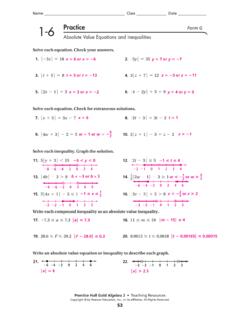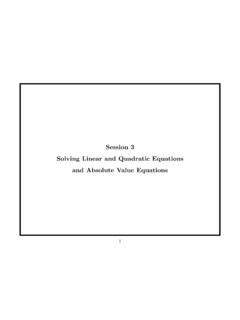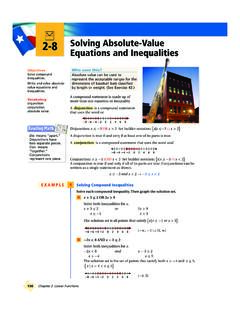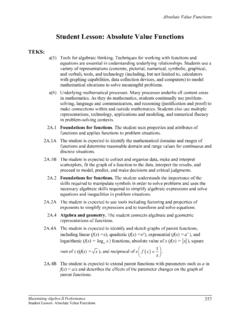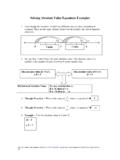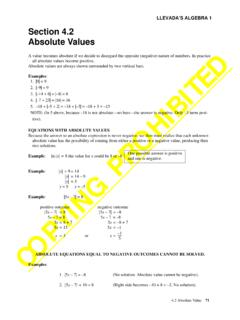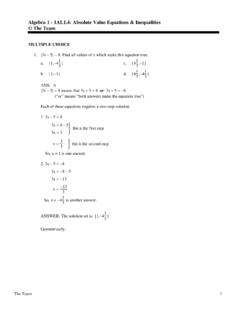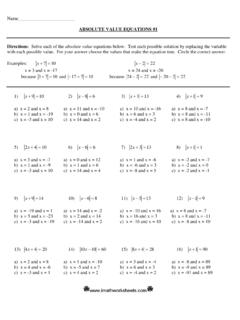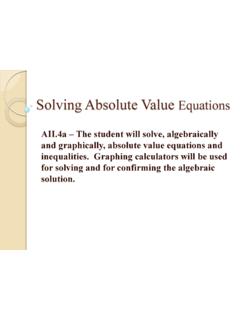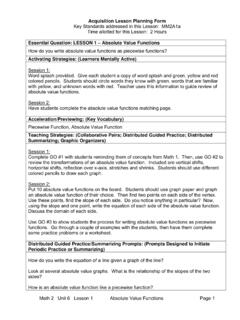Transcription of Absolute Value Equations and Inequalities; Equations and ...
1 Mathematics Enhanced Scope and Sequen ce Algebra II Vi rgi nia Department of Educati on 2011 1 Absolute Value Equations and inequalities Reporting Category Equations and inequalities Topic Solving Absolute Value Equations and inequalities Primary SOL The student will solve, algebraically and graphically, Absolute Value Equations and inequalities . Graphing calculators will be used for solving and for confirming the algebraic solutions. Related SOL Materials Graphing calculators Activity 1 Cards (attached) Three attached handouts Vocabulary union, intersection, linear inequality, Absolute Value , distance, linear equation (earlier grades) compound inequality, Absolute Value inequality ( ) Student/Teacher Actions (what students and teachers should be doing to facilitate learning) 1. Invoke students prior learning by asking questions about Absolute Value . Use questions such as the following: What is Absolute Value ?
2 What does the graph of the Absolute Value of a linear function look like? What are the solutions to |x| = 5? What are some solutions to |x| < 5? What are some solutions to |x 2| 4? Explain to students that the objective of the lesson is to learn three methods for solving Absolute Value Equations and inequalities , which will give them greater insight into the solution process. Method 1: Graphing 2. Ask students to graph 32xy and 5y by hand and then on their graphi ng calculators. 3. Next, ask students how they might use the graphs they generated to solve the following equation and inequalities : a. 532x b. 532x c. 532x 4. Have students solve each one, using the graphs. 5. Distribute copies of the attached Solve by Graphing handout, and have students complete it, using the graphing method. Mathematics Enhanced Scope and Sequen ce Algebra II Vi rgi nia Department of Educati on 2011 2 Method 2: Absolute Value as Distance 6.
3 Discuss the statement, Absolute Value represents distance. Ask students whether this is true, and if so, what it means. Have the class discuss 55 in terms of distance. 7. Ask what values make 3x true, and discuss this in terms of distance. Summa rize responses by saying, We can describe the solution set as the set of points whose distance from the origin is equal to 3. Show the solution set on a number line. 8. Ask what changes in the solution set when we want to solve 31x. Summarize responses by saying, We can describe the solution set as the set of points whose distance from 1, rather than 0, is equal to 3. It is importa nt to show the solution set on a number line. 9. Ask, If the solution to 3x is the set of points whose distance from the origin is equal to 3, then what is the solution set to 3x? Discuss this question, asking students to identify some values of x that make 3x true. They should come to see that the solution set is the set of points whose distance from the origin is less than 3.
4 Show the solution set on a number line. 10. Ask how the graph of this solution set would be different if you were solving 3x. If you were solving3x. If you were solving 3x. 11. Instruct students to use the distance method to solve the following examples: a. 32x b. 75x c. 434x d. bax Then, have them state the solution of each example, using the sentence frame in the box below. Finally, have them graph each solution set on a number line. 12. Discuss the validity of baab. Ask whether it is true. Ask whether students can think of an example in which it is not true. Once its validity is established, show this example: 532x 5232x 5232x 5232x 2523x Show on a number line that the solution set is the set of points whose distance from 23is less than 25. Sentence Frame for Solution Set The solution set to given equation or inequality, is the set of points whose distance from _____ is equal to, less than, etc.
5 _____. 1 4 2 3 3 0 3 3 3 3 0 3 3 3 3 23 4 1 253 253 Mathematics Enhanced Scope and Sequen ce Algebra II Vi rgi nia Department of Educati on 2011 3 Therefore, we can write the solution set in set-builder notation as }41|{xx. Method 3: Absolute Value as Compound Inequality 13. Explain the method of writing Absolute Value Equations and inequalities as compound statements. Students should make the connection quickly if this is the third method discussed. 5x 5x OR 5x 5x 5x AND 5x 5x 5x OR 5x 14. Have students write the following as compound statements, solve each branch, and graph the solution set to each: 62x 732x 453x 15. Give every pair of students a set of Activity 1 Cards. Explain that student pairs will play a game to match an inequality with the graph of its solution set, the statement describing its solution set, and the corresponding compound statement. Have pairs shuffle their cards and deal 8 cards each.
6 In turn, each player places one card on the table. If there is a corresponding card already on the table, the player places his/her card on top of that card to create a stack; if not, the player starts a new stack. At the end of the game, six stacks should have been created. When a student places the fourth card on any stack, that student collects that stack. The player with the most stacks wins. Once the game becomes too repetitive with these cards, have students create their own game cards in the same manner by writing inequalities , accompanying statements describing the solution sets, accompanying graphs, and accompanying compound inequalities . 16. Distribute copies of the attached Activity 2 Problems, and have students work in pairs to come up wi th three Equations or inequalities that the provi ded graphs can help them solve. Have them also write the solutions. 17. The Activity 3 Problems are designed as a review and practice session on these topics, with students assisting each other through the review process.
7 Set up six workstations with each station containing multiple sheets showing one set of problems. Be sure that each station has enough sheets for every student to have one. Place a poster at each station with the answers and full solutions to the problems. Put students into groups at the six stations. Give each group 7 to 10 minutes per station to complete the problems found there, working together and checking answers. Set a timer so that the groups know when to stop working and rota te to the nex t station. 0 5 5 5 5 0 5 5 5 5 0 5 5 5 5 Mathematics Enhanced Scope and Sequen ce Algebra II Vi rgi nia Department of Educati on 2011 4 Assessment Questions o You have noticed when you graph certain Absolute Value inequalities that the solution set is everything within an interval between two points, as demonstrated below: In other Absolute Value inequalities , the solution set is everything on the number line outside of an interval, as demonstrated below: What types of Absolute Value inequalities lead to each of these kinds of solution sets?
8 Why? o Given any interval between two given numbers, how can you write an Absolute Value inequality to produce tha t interval as its solution set? Journal/Writing Prompts o Discuss the three ways of solving Absolute Value Equations and inequalities , including which one you think makes the most sense and why. o Explain the steps you woul d use to solve an Absolute Value inequality, using your method of choice. o Write a fictitious story about the history of Absolute Value . Extensions and Connections (for all students) Have students solve problems where the argument of the Absolute Value is quadratic. Have students work in groups to reteach one of the methods, and record a video for student review. Have students develop their own mnemonic to remember the connecting compound word, and or or, for each Absolute Value equation or inequality type. Have students solve 52x, using a distance argument. Strategies for Differentiation When teaching the compound statement method, consider using a template like the one shown at right.
9 Provide additional sentence frames to help students articulate solution sets to Absolute Value inequalities . Restrict the number of game cards to two representati ons for students who struggle with multiple representations. 0 5 5 5 5 0 5 5 5 5 Absolute Value AND or OR Branch 1 Solutio n set in set-bui lder nota tion Solution set on a number line Branch 2 Mathematics Enhanced Scope and Sequen ce Algebra II Vi rgi nia Department of Educati on 2011 5 Construct a number line on the floor, and have students physically represent distances from zero and solution sets to Absolute Value Equations and inequalities . Allow students to use talking graphing calculators as they interpret graphs and points of intersection. Mathematics Enhanced Scope and Sequen ce Algebra II Vi rgi nia Department of Educati on 2011 6 Solve by Graphing Graph each of the following on a number line, and then solve: 1. 3 < x 5 2.
10 X < 1 or x 5 3. x 0 and x < 4 4. x 4 and x < 7 5. x < 5 and x > 1 6. x 4 and x > 7 7. x 4 or x > 7 8. x > 1 or x < 3 Graph on a number line the real numbers that satisfy each of the following: 9. |x| = 5 10. |x| = 0 11. |x| = 8 12. |x| 6 13. |x| 1 14. |x| = 0 15. |x 3| 5 16. |x + 3| 6 17. |x 4| 3 18. |2x 5| 16 Mathematics Enhanced Scope and Sequen ce Algebra II Vi rgi nia Department of Educati on 2011 7 Activity 1 Cards Copy cards on cardstock, and cut apart on the dotted lines. |x + 5| 4 The set of points whose distance from 5 is less than or equal to 4 x + 5 4 and x + 5 4 The set of points whose distance from 5 is less than 4 |x 5| < 4 x 5 4 and x 5 4 |x + 4| 5 The set of points whose distance from 4 is greater than or equal to 5 x + 4 5 or x + 4 5 9 1 1 9 9 1 Mathematics Enhanced Scope and Sequen ce Algebra II Vi rgi nia Department of Educati on 2011 8 |2x 1| 7 The set of points whose distance from 12 is less than or equal to 72 2x 1 7 and 2x 1 7 |2x + 1| 7 The set of points whose distance from 12 is greater than or equal to 72 2x + 1 7 or 2x + 1 7 |x 2| 7 The set of points whose distance from 2 is less than or equal to 7 x 2 7 and x 2 7 3 4 4 3 5 9 Mathematics Enhanced Scope and Sequen ce Algebra II Vi rgi nia Department of Educati on 2011 9 Activity 2 Problems For each problem.










